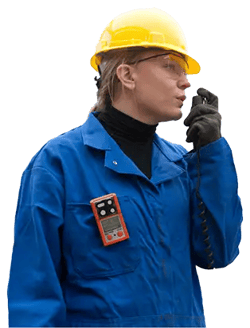COVID-19 is changing the way many people work, and the safety industry is no exception. Around the world, health and safety professionals are either leading or are heavily involved with their organizations’ COVID-19 response plans. This is lifesaving work, but also makes it hard to find time to manage day-to-day safety programs, including a gas detection fleet. At the same time, necessary safety measures make it more challenging than ever before to maintain a safe gas detection fleet.
Below are some of the most common challenges safety and health professionals need to overcome to successfully adapt a gas detection program during COVID-19.
Challenge #1: How do I clean and sanitize my gas detector?
Because many gas detectors are both A). Worn in the breathing zone and B). Shared by several users, it’s a good idea to routinely clean and sanitize your gas detectors. However, you can’t use any old cleansing agent. To give your monitor a serious cleaning, wipe it with a bleach and water solution of approximately 50 parts water to one part bleach recommended by the Centers for Disease Control (CDC).
Challenge #2: What is the proper way to use hand sanitizer around a gas detector?
Many sensors within gas detectors will react to the alcohols in hand sanitizers. Because the use of hand sanitizer is increasing, it’s essential to understand how to safely use hand sanitizer around gas monitors. Thoroughly rub the sanitizer into hands and then wait about five to ten minutes before touching the monitor.
Challenge #3: How can I distance my docking stations?
Often, docking stations are grouped together in communal areas for ease of access and use. However, for organizations wanting to follow social distancing guidelines, the proximity can present challenges. If you are thinking about relocating your docking stations, you’ll need a few things:
- Access to power outlets.
- If the docking stations are clustered or manifolded together, you will need a new regulator(s) and bottle(s) of calibration gas.
- Possible ethernet access, although not all docking stations need an ethernet port to operate.
Challenge #4: How can I properly clean my docking station?
Docking stations are shared tools, so it’s essential to clean them. To do so, use a 50:1 mixture of water and bleach to wipe any parts where the monitor contacts the docking station. For other areas of the docking station (screens/buttons/etc.), the water mixture might cause problems. For those areas, you might want to use Isopropyl alcohol (90% or above). However, make sure that if you use any alcohol-based cleaners on or near a docking station you allow enough time for those to off-gas before docking a monitor.
Challenge #5: How can I remotely bump test my monitors?
Bump testing is crucial for gas detectors and must be performed before each use. However, many remote workers may have lost access to docking stations. To do a remote bump test, you will need the following:
- A regulator and bottle of gas
- Tubing
- A cap or “calibration cap” for the monitor
- Optional: compact bump test cylinders designed for this application
Additionally, users should place their instruments into a “bump test” mode for this task for two primary reasons:
- The bump mode will ensure that all sensors have passed the bump test vs. relying on an audible alarm.
- When reviewing your gas detection data, if not placed into a “bump mode,” these alarms can easily be confused with exposures.
Challenge #6: What should I do about monitoring Chlorine Dioxide?
Chlorine Dioxide (ClO2) has emerged as a popular disinfectant in response to COVID-19, but it's also toxic at low concentrations, so you must monitor it to keep workers safe. The challenge is that calibrating ClO2 monitors requires a special ClO2 generator. With this in mind, our rental program sends you freshly-calibrated ClO2 monitors each month so you don’t need to worry about calibration.
Challenge #7: How do I adapt my program long term?
We don’t know just how long we’ll be operating differently due to COVID-19, but we should be prepared for an extended time.
You may face additional staffing or logistical challenges when it comes to gas detector maintenance and repair. Gas detection as a service programs are a good option for eliminating the burden of gas detector maintenance and adjusting your fleet size over time. Programs like this, including our iNet® Exchange, use docking stations to identify when one of your monitors needs attention. When it does, we’ll ship you a new monitor to ensure you don’t have to worry about downtime, repairs, or connecting with an on-site repair service.



